Timeline: The long road to our crumbling Met
A century after Metropolitan Blvd. was born, and a half-century after it was finally completed, a mainly elevated 12-kilometre stretch is at the end of its lifespan. A look back at the key milestones in its history.
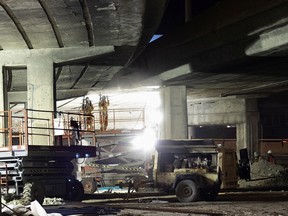
Article content
Second in a three-part series
The 100-year saga of Metropolitan Blvd. is a timeline of bad decisions and redos that never came to be, and the road ahead remains uncertain.
As it stands, the Coalition Avenir Québec government says the Met will undergo a “major” repair, but it will not be rebuilt or redesigned. A date for when the work is to begin has not been announced.
1920s
February 1922: The Board of Trade and civic authorities agree on a plan to construct a boulevard along the entire length of Montreal Island, from Ste-Anne-de-Bellevue to Bout-de-l’Île. The boulevard is to be built along Sherbrooke St. The trans-island boulevard would link to existing routes between Windsor and Ottawa and to the limits of Quebec. A committee representing different Montreal interests is created to approach the provincial legislature about granting the new Montreal Metropolitan Commission the power to construct it.
December 1922: Pointe-aux-Trembles mayor Rosaire Prieur calls on the MMC to send a delegation to Quebec City to ask for the legal power to build the trans-island Sherbrooke boulevard. Estimated cost: $1.8 million.
July 1923: The commission of municipal engineers, under the auspices of the MMC, studies the proposed island-wide boulevard, but considers an alternative east-west route further north: Crémazie Rd. Proponents say the more northern route would be less costly to build than extending Sherbrooke, and it would help to develop the north part of the island.
1925: La Presse and Le Devoir editorials denounce the boulevard as an expensive and “gigantic scheme.”
1929: The MMC is authorized to develop a plan for a boulevard across Montreal Island along Crémazie, Côte-de-Liesse Rd., St-Michel Rd. and St-Léonard Rd. The route is to link to a bridge to be built over the Ottawa River, between Ste-Anne-de-Bellevue and Île-Perrot.
1930s
1931: The route for the proposed metropolitan boulevard along Crémazie is approved.
October 1931: Plunged into the Great Depression, the Quebec government says it will finance one-third of the construction of the boulevard to create jobs for the unemployed. The MMC and city of Montreal will each kick in a third. Cost: $3 million in expropriations and $6 million in material and labour.
November 1931: Three design options are submitted to the MMC, ranging from $10.6 million to $12.55 million. The $12.55-million option is retained and includes $2.4 million for expropriation. Critics challenge the expropriation budget, saying the goal of the project is to create jobs.
January 1937: Montreal Mayor Adhémar Raynault, having campaigned on a promise to bring the 1942 World’s Fair to Montreal for the city’s 300th anniversary, asks the city executive committee to set up an organizing committee. The head of Montreal’s urban planning commission, H.-A. Terreault, suggests Rivière-des-Prairies or Montreal North as possible sites because of available vacant land. Montreal needs to build the metropolitan boulevard to make the area accessible, Terreault says. (Second World War cancels the 1942 World’s Fair in Rome.)
March 1937: The council of Jacques-Cartier County, a regional body that includes the municipalities of what is later known as the West Island, plus Ville St. Laurent and Town of Mount Royal, writes to Quebec Premier Maurice Duplessis to “humbly beg” the province to build the metropolitan boulevard as “an urgent improvement that would bring great relief to the working class.”
1940s
March 1944: The “rural” municipalities of the island protest their bills from the MMC to pay for the ‘Metropolitan Boulevard’ plans.
March 1949: The MMC approves the route for the boulevard in Pointe-aux-Trembles. The western section, from Ste-Anne-de-Bellevue to Graham Blvd. in Town of Mount Royal, has been built over the years. What’s left to build: from Graham to Bout-de-l’Île. MMC chairman J. O. Asselin comments that “the entire project could now be completed for less than $8 million” since the western section is done, the Gazette reports.
November 1949: The federal government announces it will pay half the construction cost of the Trans-Canada Highway if the provinces pay the other half. The MMC complains it has tried repeatedly to have the metropolitan boulevard included in the Trans-Canada to benefit from federal and provincial contributions, to no avail.
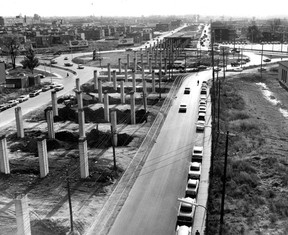
1950s
May 1950: The MMC urges Montreal to approve the plans for Metropolitan Blvd. and authorize construction on its territory. The MMC is responsible for the portions in the suburbs. The MMC no longer wants to wait on the higher levels of government, which are dragging their feet.
September 1952: The island municipalities give the green light to expropriate properties for Metropolitan Blvd.
December 1953: The boulevard “super-highway” is to have roundabouts in the east end at a cost of almost $1 million. Overhead roads are planned on de la Rousselière Blvd. over Sherbrooke St., just below the Chapelle de la Réparation, where Metropolitan Blvd. is to merge with Sherbrooke via an extended Leduc Blvd. (later renamed Henri-Bourassa Blvd.).
August 1954: The MMC decides the portion west of Décarie Blvd. to Bout-de-l’Île will be built as an elevated expressway. Estimated cost: $35 million, or double what was previously presented. Some sections might carry a toll. The MMC’s metropolitan boulevard sub-committee recommended the elevated structure, supported by the MMC’s engineers. Ville St. Laurent and Town of Mount Royal oppose the elevated expressway next to their municipalities, saying it will depreciate the value of properties adjacent to it.
February 1956: The MMC issues a call for tenders to build the grade separation at the Décarie/Côte-de-Liesse intersection. The boulevard right-of-way has to be moved in the west end due to the planned expansion of Montreal Airport in Dorval.
March 1957: T.M.R. council presents its own engineers’ plan for a ground-level expressway adjacent to the municipality at a savings of over $10 million. T.M.R. says a surface highway could be constructed “with much greater simplicity and in much less time” and allow for trees and grass. Ville St. Laurent council also “strongly” opposes the elevated highway next to it.
April 1957: The North End Businessmen’s Association calls for Metropolitan Blvd. to be built at grade rather than elevated.
May 1957: Other than the stretch adjacent to T.M.R. and St. Laurent, construction of Metropolitan Blvd. moves ahead. The projected cost now stands at $50 million.
June 1957: Montreal Mayor Jean Drapeau and executive committee chairman Pierre DesMarais fail to muster the required two-thirds majority on council to appropriate $10.5 million to build the Montreal portion of Metropolitan Blvd. Councillors object to the elevated design. DesMarais urges councillors “who want to see Montreal continue to develop, who want to see it maintain its status as the metropolis of Canada” to vote in favour. He says St. Laurent and T.M.R. will come around once they see how nice the elevated structure is in the east end. The appropriation carries, 50 to 23, in a second vote.
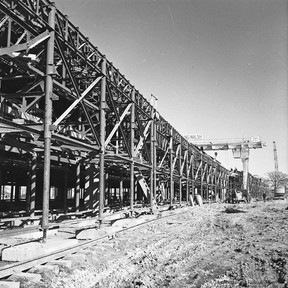
May 1958: The MMC, T.M.R. and St. Laurent agree to let an impartial engineer recommend whether to build the Met at surface or elevated adjacent to the two municipalities.
September 1958: The MMC votes 8-2 to approve the impartial engineering firm’s compromise, which recommends sections of Metropolitan Blvd. next to T.M.R. and St. Laurent be at-grade. Montreal’s representatives are the only MMC members to vote against. T.M.R. Mayor Reginald Dawson and St. Laurent Mayor Maurice Cousineau are satisfied with the compromise.
June 6, 1959: The MMC awards an $8,898,000 contract to Simard et Frères Cie. Ltée to build a 10,000-foot-long portion of the elevated expressway, including the Décarie/Côte-de-Liesse traffic circle. The Met price tag rises to $122,650,855.
December 1959: Eager motorists can’t wait to drive on Metropolitan Blvd. They’ve been moving “No Traffic” signs and cement barriers to get on it. A car crashes through the railing on the elevated expressway near St-Hubert St. and four occupants are injured.
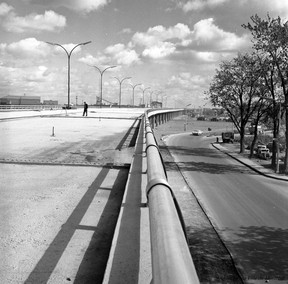
1960s
Jan. 24, 1960: Metropolitan Blvd. officially opens. It runs 5.5 miles (nine km), from just west of Laurentien Autoroute to just east of Pie-IX Blvd. The estimated $122-million cost will be borne by the municipalities of Montreal Island in proportion to each municipality’s taxable real estate value. It’s designed to handle 89,000 vehicles a day. Quebec considers participating financially in the federal Trans-Canada Highway project, but the Met isn’t included in the route.
February 1960: The MMC passes a bylaw setting the speed limit for cars on Metropolitan Blvd. at 55 miles an hour (89 km/hr) during the day and 50 miles an hour (80 km/hr) at night between Pie-IX and Authier St., and at 60 miles an hour (97 km/hr) during the day and 55 miles an hour at night elsewhere on the expressway. The speed limit for trucks and buses is five miles an hour (8 km/hr) lower in each case. Trucks and buses are required to keep to the right-hand lane, except for passing.
June 1960: Quebec Premier Antonio Barrette promises that if his Union Nationale government is re-elected, the province will foot half the cost to build Metropolitan Blvd. Union Nationale loses the provincial election to Jean Lesage’s Quebec Liberal Party, which has promised the province will pay the full cost of the expressway.
October 1960: Ottawa announces Metropolitan Blvd. will be part of Trans-Canada Highway.
April 1961: The Quebec government passes Bill 43, acquiring Metropolitan Blvd. from the municipalities of Montreal Island. Quebec will pay the full $122 million (estimated) construction cost and reimburse municipalities what they’ve already paid.
July 1962: Insurance companies are concerned that 14 vehicles have crashed through the guardrails on the elevated Met, leading to four deaths. Quebec Provincial Police consider asking to lower the speed limit to 45 mph (72 km/h).
August 1962: The government sends test cars crashing into redesigned guardrails on the Met at 55 mph. Cost of nine test cars: $2,000.
August 1963: Montreal, Ottawa and Quebec announce an agreement to build the Montreal section of Trans-Canada Highway. Quebec is to assume $100 million of the cost, the feds $40 million and Montreal $35 million.
April 1964: Metropolitan Blvd. is being extended as far as Montée St-Léonard. Premier Lesage announces the boulevard will reach the east end of the island by 1967.
October 1964: Traffic on Metropolitan Blvd. is estimated at 100,000 vehicles a day.
April 1967: Décarie Expressway opens on the same day as the World’s Fair opens in Montreal. (Louis-Hippolyte La Fontaine bridge-tunnel was inaugurated in March.)
December 1969: Montreal Star traffic columnist Len Rowcliffe laments traffic jams caused by truck breakdowns on the Met and bumper-to-bumper traffic between Côte-de-Liesse and Laurentian Autoroute. The province resists calls to ban trucks on the Met during rush hour.
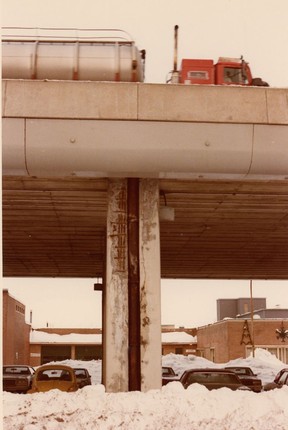
1970s
1971: Construction of Metropolitan Blvd. to the eastern end of the island is completed. Quebec Premier Robert Bourassa refers to “intolerable” traffic congestion on it.
1974: Traffic on the Met in front of the National Film Board headquarters averages 115,000 vehicles a day.
Spring 1977: Major repair work begins on Metropolitan Expressway, between Laurentian Autoroute and Côte-de-Liesse Circle. Quebec awards a $5-million contract to Simard et Beaudry for the first phase. The stretch gets 120,000 vehicles a day. The repairs won’t improve the “insufferable” traffic congestion, the provincial roads department acknowledges. The ministry says the cost to widen the boulevard to add emergency shoulders is prohibitive. Traffic at the most congested part, Décarie Interchange, is 130,000 vehicles a day in both directions.
As part of the repair, the Quebec roads department awards a contract to Plastibeton Inc., co-founded by Peter Trent (later the mayor of Westmount), to install protective panels made of the firm’s patented polymer concrete to cover the crumbling sidewalls. (These panels are removed years later when the province finally repairs the concrete underneath.)
April 1979: Major repair of the Met continues towards Pie-IX. Estimated cost: $6.5 million.
1980s
1981: An average of 125,000 vehicles pass the NFB on the Met each day.
December 1987: Transport Minister Marc-Yvan Côté announces his government is considering a $2-billion plan to build beltways on the North Shore and South Shore around Montreal Island and to repair and improve safety on the Met and Décarie Expressway. It’s part of a 10-year plan to reduce congestion.
April 1988: The Met is described in one Gazette article as a “traffic planner’s bad joke and every motorist’s nightmare … a crumbling concrete colossus that’s perpetually snarled with traffic.” The Met earns the title of the worst designed, most dangerous highway in North America, with an accident rate that is four times the North American average for a highway of its kind. An SNC/Deluc study reveals the Met’s design fails to meet world standards and norms on at least a dozen points. Traffic on the Met is 170,000 vehicles a day, and it’s projected to increase by 15 per cent over 10 years.
Quebec announces it will soon go to tenders to carry out $50 million in “badly needed renovations” on the Met.
May 1988: Côté announces his government has decided not to close Metropolitan Blvd. for a year to carry out the major repairs but rather to spread it out over five years. A complete shutdown would hurt the economy, he says.
The transport department admits the Met was ill-conceived — its designers didn’t anticipate the weight of trucks to come or traffic growth. Experts in the early 1960s estimated that daily traffic volume would barely surpass 100,000 by the year 2000. Now 175,000 vehicles are using the autoroute, says transport department spokesperson Yvan Paquette. The Met’s concrete columns are “dangerously” cracked, especially around St-Michel/Christophe-Colomb. Every day, plates of concrete detach and fall on the roadway. Rusted steel rods are exposed in crumbling concrete. The road surface is broken in many places, with major water infiltration in spots. “It’s the whole structure that’s weakened,” Paquette says.
Ministry insiders say the scenario of demolishing the elevated expressway and rebuilding it from scratch is on the table, estimating that would cost less than doing $300 million in major upgrades.
January 1989: Montreal’s mayor, Jean Doré, calls the Met obsolete and suggests demolishing the elevated structure and replacing it with a tunnel. Transport Minister Côté calls him “Prince Doré” and says he’s “financially and intellectually irresponsible” for suggesting the tunnel. However, all of the Montreal Urban Community’s 29 mayors demand the “crumbling” Metropolitan be completely rethought, not just repaved.
April 1989: “This expressway has been out of date for 25 years and it has always been a wall that has split the city in two,” Doré says. His proposal to replace the Met with a tunnel topped with a surface level urban boulevard is “gaining ground,” he says. Cost could be $2 billion, he says. It’s revealed Côté has agreed to study an underground expressway.
1990s
April 1990: A $60-million “major” repair of Metropolitan Blvd. begins on a 15-km section between Anjou Interchange and Côte-de-Liesse. It’s the biggest road repair project ever undertaken in Montreal. Mayor Doré again criticizes the decision to repair rather than replace the Met.
October 1993: A two-year study by Dessau/LGL for the Quebec Transport Department and Montreal Urban Community recommends building a two-lane tunnel linking the Décarie Expressway to the Laurentian Autoroute (Highway 15 N) so motorists can bypass the Met. It also recommends widening service roads, eliminating some exits and entrances, adding a fourth lane as an express lane in each direction in certain places, including the Décarie Interchange, and redoing the Papineau and L’Acadie circles. Estimated cost: $345 million.
An alternative proposed in the report: demolish the elevated Met and replace it with a 9-km tunnel from Côte-de-Liesse to Pie-IX, with two lanes in each direction and build a 5-km surface boulevard on top from St-Laurent to Pie-IX with five lanes in each direction, including a lane reserved for public transit in each direction. Estimated cost: $1.2 billion.
December 1998: The Quebec minister responsible for the Montreal region, Robert Perreault, says Transport Quebec is working on a plan to solve the region’s traffic problems. One of the solutions being looked at: widening the Met between Highway 13 and Highway 25 to create a truck reserve lane.
March 1999: Quebec says it won’t be starting a “long-awaited” major repair of the Met that year, after all. The project is to cost $850 million over five years.
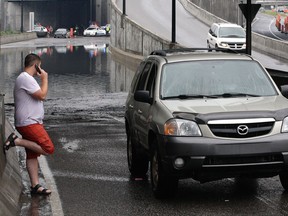
2000s
April 2000: Quebec announces an impending $762.3-million “major” repair for the Met. The government also says it’s considering turning the Met into a double-decker highway by adding a new level six metres above the existing one from Côte-de-Liesse to just past the Décarie Interchange. Another option is to add two lanes and keep the Met one level. Burying the Met would cost $500 million per kilometre, or $5.5 billion.
June 2000: Traffic expert Rick Leckner and Concordia engineering professor Bala Ashtakala warn that Montreal’s “overused and aging expressways are in danger of crumbling faster than Transport Quebec’s ability to see and repair the damage” in the wake of the Highway 15 overpass collapse in Laval a few days earlier.
March 2002: Transport Minister Serge Ménard announces $39.5 million over 10 years to create a public-private project office to manage the coming repair of the Met. The estimated repair cost is $760 million. Repairs are to start in 2004 and include correcting entrances and exits and rebuilding most of the section between Décarie and Highway 15 north.
August 2003: The repair planned to start in 2004, now estimated at nearly $1 billion, is postponed. The government will again study the feasibility of a tunnel, this time from Décarie to Laurentian Autoroute. The Charest government cancels the private-public project office and the idea of a PPP to repair the Met.
2005: L’Acadie Circle linking Highway 40 with Highway 15 is rebuilt after four years and $110 million to correct its original flawed design. The redo was supposed to cost $58 million. The new circle lacks proper rain collection areas, which will cause flooding during heavy rains.
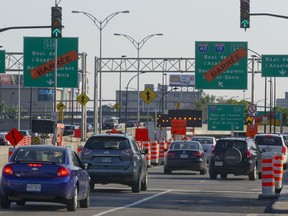
2010s
September 2014: Transport Quebec is said to be finalizing a pre-project study to determine what work is needed to rehabilitate the Met between Côte-de-Liesse and Provencher. Transport Quebec nixes the idea of levelling or rebuilding the expressway. Traffic is at 190,000 vehicles a day.
Montreal city councillor Richard Bergeron, a member of the city executive committee, says: “They won’t touch Highway 40 for another 10 years because we’re stuck with (projects for) the Turcot Interchange, the St-Pierre Interchange, Champlain Bridge. … We will pray to heaven every day that pieces of concrete don’t come off the Metropolitan.”
July 2015: Repairs to L’Acadie Circle begin after five major floods and many smaller ones since its reconstruction a decade earlier. A subterranean water retention basin is to be installed so that sewers don’t overflow during heavy rain. Expected cost: just over $2 million.
Aug. 9, 2016: A diesel truck carrying heating fuel on the Met above Lajeunesse St. crashes into the rear of a flatbed truck during rush hour and bursts into flames. The driver of the diesel truck dies. The accident prompts questioning whether to allow trucks with dangerous materials onto the expressway.
Traffic engineer Ottavio Galella says burying the Met as a tunnel is the best option because transit traffic could take the tunnel, while local traffic and trucks could use a surface boulevard above it.
2019: The Coalition Avenir Québec government’s junior transport minister, Chantal Rouleau, declares the Met will get a “major” repair but will not be rebuilt or redesigned.
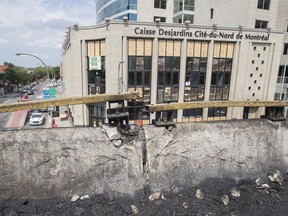
2020s
January 2020: Transport Quebec announces the Met repair is so big, it will be split in two. The ministry awards a $16.8-million (plus tax) engineering contract to the consortium Stantec/CIMA+/FNX-INNOV to prepare plans for the 5.2-km eastern portion, between St-Laurent and Provencher Blvds. Repair of this section is supposed to start in 2024 or 2025.
August 2021: Transport Quebec launches a call for tenders to award an engineering contract to prepare plans for the 6.2-km western section of the Met from Côte-de-Liesse to St-Laurent Blvd. Consortium Alliance Métropolitaine wins the $22-million (plus tax) contract.
April 2022: The CAQ government unveils a new $6.5-billion version of “3rd link” tunnel it wants to build in Quebec City. It hasn’t announced when the Met repair will begin.








Postmedia is committed to maintaining a lively but civil forum for discussion. Please keep comments relevant and respectful. Comments may take up to an hour to appear on the site. You will receive an email if there is a reply to your comment, an update to a thread you follow or if a user you follow comments. Visit our Community Guidelines for more information.